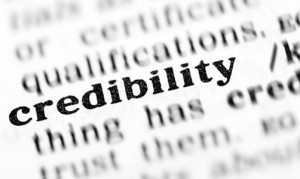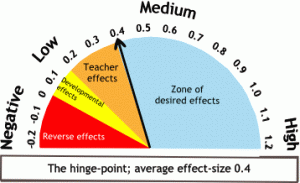This is post number seven in a ten part blog series (you may click here to start from the beginning).
This blog series serves to highlight the most significant findings from John Hattie’s 2012 work, Visible Learning for Teachers: Maximizing Impact on Learning and their applications to our classrooms. His work has given educators quantifiable insights that have no parallel in the field of education.
Need an introduction or a crash course on the effect sizes referenced below? An effect size of 0.40 is what Hattie refers to as a hinge-point regarding what is significantly effective or at “a level where the effects of innovation enhance achievement in such a way that we can notice real-world differences” (Hattie, 2009). Anything between a 0.00 and 0.39 is growth, but is not considered significant growth. Anything below a 0.00 is considered detrimental to student growth.
Number 4 – Teacher Credibility (effect size = 0.90)
Students’ perceptions of their teachers carry incredible weight in their determination of a teacher’s credibility. John Hattie stated in a 2012 article that “The key is the students’ perception that teachers have credibility in enhancing their learning. Students are very perceptive about knowing which teachers can make a difference to their learning. And teachers who command this credibility are most likely to make the difference.” Although important, the focus here is not on the teacher’s’ perception of themselves, but instead on the students’ perception of them. Hattie states that students will turn off if they do not perceive the teacher as credible. 
Application to the Classroom
If you are looking for applications to best integrate teacher credibility into our environment then Drs. McKroskey, Haskins and Fink are a great resource (“Make Them Believe in You”). They have researched and shared the four key credibility factors: trust, competence, dynamism, and immediacy. In more detail, here are some of their findings:
Trust begins with the students believing the teacher has their best interest at heart, are fair, include everyone, do not embarrass them, and take in an interest in their life outside of school.
Competence means not just mastering a subject area, but also delivering it meaningfully. This necessitates the critical skill of being able to explain complex ideas and material in a way students can understand. This is another example of Hattie’s idea of Visible Learning where teachers must be able to see learning through the eyes of their students in order to be effective explainers.
Dynamism is focused on the learning being presented in “exciting and engaging ways.” This requires a variety of techniques and enthusiastic interactions and deliveries.
Immediacy refers to using approaches and techniques that reduce the physical and communicative distance between students and teachers including moving out from behind podiums, grouping classes in circles, and using inclusive language (i.e. we or us).
A Random Mention
Number 98 out of 150 – Teaching Test-Taking and Coaching (effect size 0.22)
This concept refers to the practice of test preparation activities focused on improving test scores. The impact of these strategies were moderate, but present, across a number of meta-analyses. Findings, largely focused on the SAT, showed that effects were higher the longer the duration, the higher the grade, the lower the socioeconomic status, and when there was a focus on practice and instruction on answering particular items versus taking complete examinations. Familiarity with the examination process and examiner served to reduce anxiety as well.
A Peek at the Bottom 10
Number 144 out of 150 – Student Control Over Learning (effect size 0.04)
Hattie spends very little time explaining this finding which is somewhat surprising given its perceived contradiction with his overall emphasis on visible learning and the powerful impact of students becoming their own teachers. He cites that student choice and control over learning is higher on motivational outcomes in comparison to student learning. Perhaps student control over learning in this case is meant to be interpreted in the most literal sense that the teacher has no input on learning objectives or outcomes and students call all of the shots.
For more from this blog series view the following posts:
#8 – Comprehensive Interventions for Learning Disabled Students
#5 – Providing Formative Evaluation of Programs
Hattie, J., Visible Learning: A Synthesis of Over 800 Meta-Analyses Relating to Achievement (2009)
Hattie, J. Visible Learning for Teachers: Maximizing Impact on Learning (2012)
“Make Them Believe in You” https://www.tes.com/article.aspx?storycode=6179294
http://visible-learning.org/glossary/#4_Teacher_credibility
Credibility image retrieved from: https://tjohnsonmediagroup.com/blog/7-ways-to-gain-listener-credibility/
Effect size image retrieved from: http://www.learningandteaching.info/teaching/what_works.htm





Leave a Reply